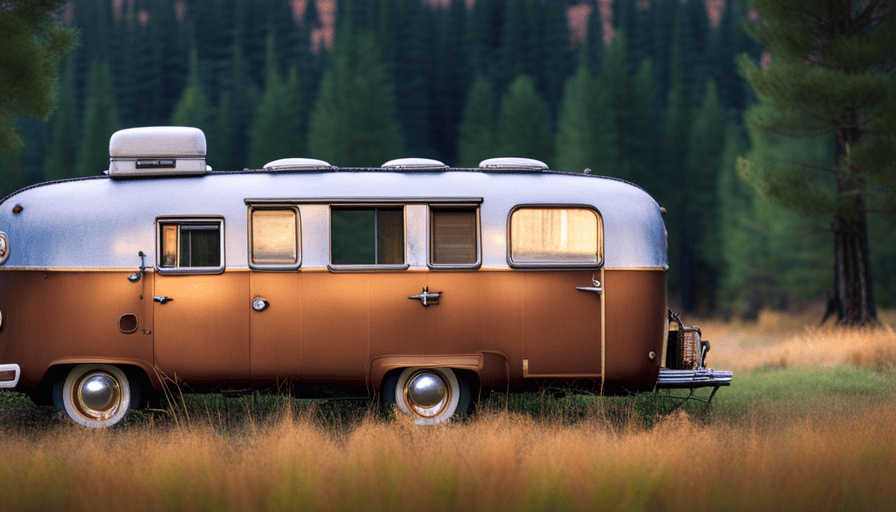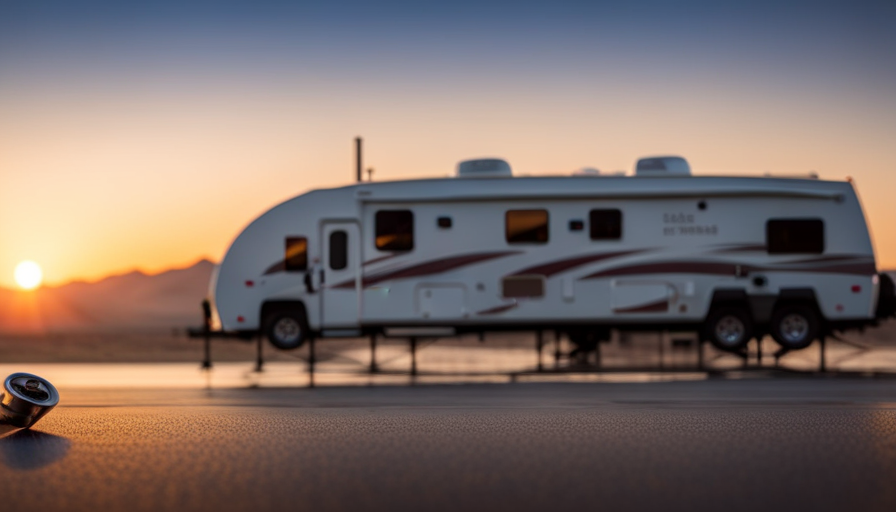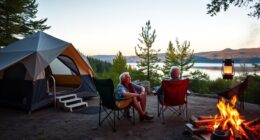Are you fantasizing about embarking on a road trip and discovering the beauty of nature? Picture yourself with a compact camper trailer that lets you journey in comfort to any destination your heart desires.
Well, I’m here to tell you that building your own camper trailer is within reach. In this article, I will guide you through the step-by-step process of constructing a small camper trailer that is tailored to your needs and budget.
First, we will determine your specific requirements and financial limitations. Then, we will research and gather the necessary materials, ensuring we have everything we need to complete the project successfully. Once we have a clear vision, we will create a detailed design and floor plan, ensuring every inch of space is utilized efficiently.
Next, we will dive into the construction process, building the frame and structure of the camper trailer. We will then focus on insulation and wiring, ensuring your home on wheels is both comfortable and powered. Plumbing and appliance installation will follow, giving you the convenience of a fully functional kitchen and bathroom.
Finally, we will add the finishing touches and decor, making your camper trailer feel like a cozy home away from home. Before hitting the road, we will thoroughly test and ensure the safety and functionality of your DIY creation.
So, if you’re ready to embark on a rewarding and fulfilling journey of building your own small camper trailer, let’s get started!
Key Takeaways
- Determine specific requirements and financial limitations
- Research and gather necessary materials
- Create a detailed design and floor plan for space utilization
- Construct the frame and structure
Determine Your Needs and Budget
Before diving into the exciting world of building your own small camper trailer, take a moment to assess your needs and budget.
Determining your needs is crucial as it will dictate the size, layout, and features of your camper trailer. Consider how many people will be using it and what amenities are essential for your comfort. Will you need a kitchenette, bathroom, or sleeping quarters?
Setting a budget is equally important to ensure that your project remains financially feasible. Take into account the cost of materials, tools, and any professional assistance you may require. Research the market to get an idea of the average cost of camper trailers with similar specifications to yours.
Once you have determined your needs and set a budget, you can move on to the next step of your camper trailer project: researching and gathering materials. This stage is vital for acquiring the necessary components to bring your small camper trailer to life.
Research and Gather Materials
First, you’ll want to gather all the necessary supplies and materials for your amazing little home on wheels. To begin, gather resources by conducting thorough research on the specific materials you’ll need for your camper trailer. This includes items like insulation, plywood, aluminum siding, electrical components, plumbing supplies, and various hardware. Compare prices from different suppliers to ensure you’re getting the best deals and quality for your budget.
Once you have a list of materials, create a detailed spreadsheet or document to keep track of the quantities and costs. This will help you stay organized and within your budget. Consider purchasing materials in bulk or from wholesalers to save money.
Additionally, it’s important to gather the necessary tools and equipment for the construction process. This may include items like a circular saw, drill, tape measure, level, and various hand tools. Make sure you have everything you need before you begin building to avoid any delays or setbacks.
By gathering all the necessary supplies and materials and comparing prices, you can ensure that you have everything you need to start building your small camper trailer. Once you have everything in place, you’ll be ready to move on to the next step of creating a design and floor plan.
Create a Design and Floor Plan
Now that you’ve gathered all the necessary supplies and materials, it’s time to let your creativity flow and design a unique and functional layout for your dream home on wheels. When creating a design and floor plan for your small camper trailer, there are several design considerations and space optimization techniques to keep in mind.
-
Layout: Start by determining the overall layout of your camper trailer. Consider the placement of essential components such as the bed, kitchenette, bathroom, and storage areas. Think about the flow of the space and how you can maximize functionality.
-
Storage: One of the key challenges in a small camper trailer is maximizing storage space. Incorporate clever storage solutions such as under-bed storage, overhead compartments, and pull-out drawers. Utilize vertical space and consider multi-functional furniture with built-in storage.
-
Multi-purpose Areas: Make the most of limited space by designing multi-purpose areas. For example, your dining area could double as a workspace or a seating area that converts into a bed. Think creatively about how each area can serve multiple functions.
Now that you have a well-thought-out design and floor plan, it’s time to move on to the next step and build the frame and structure of your small camper trailer.
Build the Frame and Structure
Once you have your design and floor plan in hand, it’s time to construct the sturdy foundation and framework for your compact mobile dwelling. Building a small camper trailer requires specific building techniques and the use of necessary tools.
The first step in building the frame and structure is to gather all the required materials, such as lumber, screws, and brackets. It’s crucial to measure and cut the lumber according to your design specifications, ensuring precise dimensions for a secure and stable frame.
Next, assemble the frame using appropriate techniques, such as butt joints and angle brackets, to ensure structural integrity. It’s essential to use a level and square to ensure that the frame is straight and square.
Once the frame is complete, reinforce it by adding cross braces and corner brackets. These components provide additional stability and strength to the structure.
With the frame and structure in place, the next section will focus on the installation of insulation and wiring, ensuring a comfortable and functional living space inside the camper trailer.
Install Insulation and Wiring
Transform your compact mobile dwelling into a cozy and efficient living space by installing insulation and wiring. Insulation is crucial for maintaining a comfortable temperature inside your camper trailer, especially during extreme weather conditions.
Here are some insulation techniques to consider:
- Spray foam insulation: This method provides excellent coverage and seals all gaps, ensuring maximum insulation efficiency.
- Reflective insulation: This type of insulation reflects heat away from your camper, keeping it cooler in hot weather.
- Fiberglass insulation: Easy to install and widely available, fiberglass insulation is a cost-effective option that provides good thermal insulation.
When it comes to wiring, safety should be your top priority. Follow these measures to ensure a secure electrical system:
- Use the appropriate wire gauge for each circuit to prevent overheating and potential fire hazards.
- Install a ground fault circuit interrupter (GFCI) to protect against electrical shocks.
- Route wires away from heat sources and sharp edges to prevent damage.
- Label all circuits and switches for easy identification and troubleshooting.
With insulation and wiring in place, your camper trailer will be well-prepared for comfortable living.
In the next section, we’ll explore how to build and install furniture and storage, maximizing the functionality of your cozy abode.
Build and Install Furniture and Storage
Creating a cozy and efficient living space in your compact mobile dwelling involves crafting and installing furniture and storage that will astound and amaze. When it comes to furniture design, it is important to prioritize functionality and space optimization. Utilizing modular furniture pieces can help maximize the limited space available in a small camper trailer.
To begin, consider incorporating a 2 column and 4 row table into your design. This table can serve as a multipurpose surface for dining, working, and storage. On one side of the table, install foldable chairs that can be easily tucked away when not in use. The other side can feature built-in drawers or cabinets for storing essential items such as utensils, plates, and cooking supplies.
When it comes to storage organization, think vertically. Utilize the walls to install shelves or hanging storage units that can hold clothing, towels, and other personal belongings. Additionally, consider incorporating storage compartments under seating areas or beds to further maximize space.
By carefully planning the layout and design of your furniture and storage, you can create a functional and comfortable living space in your small camper trailer. With furniture that seamlessly combines multiple functions and storage that optimizes every inch of space, you can make the most of your compact mobile dwelling.
In the next section about installing plumbing and appliances, we will explore how to efficiently incorporate these essential components into your camper trailer.
Install Plumbing and Appliances
To make your compact mobile dwelling feel like a comfortable home, it’s time to install plumbing and appliances that will bring convenience and functionality to your space. Choosing the right appliances is crucial to ensure they fit within the limited space of your camper trailer.
Look for compact and energy-efficient appliances that are specifically designed for small living spaces. Consider appliances such as a mini fridge, a compact stove, and a small microwave that’ll provide you with the necessary amenities while saving valuable space.
When it comes to selecting the best plumbing fixtures, prioritize functionality and durability. Look for compact and lightweight fixtures that are specifically designed for RVs and campers. Consider installing a small sink with a built-in faucet that can be folded away when not in use. Opt for a compact and efficient toilet that can conserve water and fit within the limited space of your camper. Additionally, consider installing a compact shower that can be easily folded or mounted on the wall to save space.
By choosing the right appliances and plumbing fixtures, you can ensure that your camper trailer provides all the necessary amenities while maximizing space efficiency. With plumbing and appliances in place, it’s time to add the finishing touches and decor to make your small camper trailer feel like a cozy home.
Add Finishing Touches and Decor
Now it’s time to put the final touches on your cozy mobile home by adding decor and personal touches. When it comes to camper trailer decor ideas, DIY trailer interior design allows you to express your creativity while maximizing the limited space available. To help you visualize the possibilities, I have prepared a 2 column and 5 row table below:
| Decor Ideas | Description |
|---|---|
| Nature-inspired theme | Incorporate earthy colors, natural materials, and botanical elements. |
| Minimalist design | Embrace simplicity with clean lines, neutral tones, and clutter-free spaces. |
| Vintage charm | Use retro furniture, antique accessories, and nostalgic artwork. |
| Coastal vibes | Create a beachy atmosphere with shades of blue, seashells, and nautical accents. |
| Bohemian style | Mix patterns, textures, and vibrant colors for a free-spirited ambiance. |
By considering these options, you can transform your camper trailer into a personalized oasis on wheels. Once you have added the finishing touches and decor, the next step is to test and ensure the safety and functionality of your newly built small camper trailer.
Test and Ensure Safety and Functionality
Once you’ve added the finishing touches and decor to your cozy mobile home, it’s crucial to thoroughly test and ensure the safety and functionality of your newly crafted home on wheels.
To do so, follow these testing methods and maintenance checklist:
-
Electrical System: Test all electrical components, such as lights, outlets, and appliances, to ensure they’re working properly. Check for any loose connections or faulty wiring that may pose a safety hazard. It’s essential to have a fire extinguisher on board and test it to ensure it’s in good working condition.
-
Plumbing System: Inspect the water system for leaks or weak spots in the pipes. Run water through all faucets and check for proper drainage. Test the water heater and ensure it heats water efficiently. Also, check the propane system for any leaks or malfunctions.
-
Structural Integrity: Carefully inspect the trailer’s frame, walls, and roof for any signs of damage or weakness. Check all doors, windows, and locks to ensure they function correctly. Test the stability of the trailer by driving it on various road conditions and checking for any excessive swaying or vibrations.
Once you have completed the testing and maintenance checklist, you can hit the road and enjoy your DIY camper trailer!
Hit the Road and Enjoy Your DIY Camper Trailer!
Get ready to embark on an exciting adventure with your newly crafted mobile home – hit the road and revel in the joy of your DIY camper trailer!
Before you set off, it’s important to ensure you have all the road trip essentials for a smooth and enjoyable journey. First and foremost, make sure you have a reliable GPS system or navigation app to guide you along the way. Additionally, pack a basic toolkit with essential tools for any minor repairs that may be needed on the road.
When it comes to budget-friendly camping tips, there are several ways to save money while still enjoying the great outdoors. Consider cooking your own meals instead of eating out by bringing a portable stove and cooking utensils. This will not only save you money but also give you the freedom to eat wherever you choose.
Another tip is to look for free or low-cost camping sites along your route. Many national parks and public lands offer affordable camping options where you can immerse yourself in nature without breaking the bank.
So, get ready to hit the road and embark on an unforgettable adventure in your DIY camper trailer. With the right road trip essentials and budget-friendly camping tips, you can enjoy the freedom of the open road without worrying about your budget.
Happy travels!
Frequently Asked Questions
How do I legally register and license my DIY camper trailer?
To legally register and license my DIY camper trailer, I need to follow a few steps.
First, I must contact my local Department of Motor Vehicles (DMV) to obtain the necessary forms and requirements.
After completing the paperwork and paying any fees, I can then register the trailer and receive a license plate.
To ensure proper insurance coverage, I should contact my insurance provider and inquire about adding the camper trailer to my policy.
Once registered and insured, I can start exploring different campsites for my adventures.
What are some common challenges or obstacles that people encounter when building a small camper trailer?
When building a small camper trailer, there are some common mistakes that people often encounter. One of the most common challenges is underestimating the budget. It’s crucial to carefully plan and budget for all the necessary materials, tools, and equipment.
Another challenge is not considering weight distribution and balance, which can lead to safety issues. To overcome these obstacles, it’s important to research and seek advice from experienced builders. It’s also important to prioritize safety and budgeting throughout the construction process.
Are there any specific safety regulations or requirements that I need to consider when building a camper trailer?
When it comes to building a camper trailer, safety regulations and requirements should be at the forefront of your mind. Adhering to these guidelines ensures the protection of yourself and others on the road.
From proper lighting and braking systems to weight distribution and structural integrity, every aspect of your build must meet the necessary safety standards.
Additionally, selecting the right building materials is crucial to guaranteeing a sturdy and secure camper trailer that will withstand the test of time.
How can I effectively maximize the storage space in my small camper trailer?
To effectively maximize the storage space in my small camper trailer, I employ various strategies.
Firstly, I utilize vertical space by installing shelving units or hanging organizers. These allow me to store items such as clothing, kitchen supplies, and camping gear.
Additionally, I make use of under-bed storage compartments and utilize collapsible storage containers to optimize space.
Organizing storage by category and labeling containers further enhances accessibility and efficiency.
What are some tips for maintaining and properly caring for a DIY camper trailer to ensure its longevity?
To ensure the longevity of your DIY camper trailer, proper maintenance and care are essential. Here are some tips to keep your trailer in top condition.
Regularly inspect and clean the exterior, paying attention to seals and joints. Check the tires for wear and maintain proper inflation.
Keep the interior clean and dry, preventing mold and mildew.
Service the mechanical components, such as brakes and suspension, as recommended by the manufacturer.
Following these tips will help your camper trailer last for years to come.
What is the weight capacity of a small camper trailer that I can build myself?
When building a small camper trailer on your own, it’s crucial to consider the weight capacity. The weight of a 25 ft camper is a significant factor in determining the materials you should use and the design you should follow. Ensuring structural integrity and staying within the weight limits will enable you to have a safe and functional self-built camper trailer.
Conclusion
In conclusion, building a small camper trailer requires careful planning, research, and a bit of DIY know-how. By determining your needs and budget, gathering the necessary materials, and creating a detailed design, you can begin constructing a solid and functional frame.
From there, it’s all about insulation, wiring, plumbing, and adding the finishing touches. Remember the adage ‘measure twice, cut once’ to ensure precision throughout the process.
Once complete, you can hit the road and embark on exciting adventures in your very own homemade camper trailer. Happy travels!










